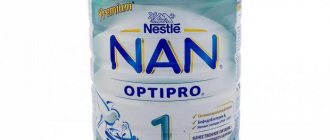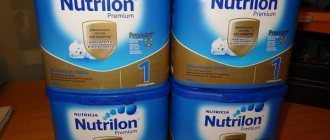A child should be transferred to milk formula only after the permission of the pediatrician, since milk impurities may contain components that can cause an allergic reaction in the child. In addition, all mixtures have a certain composition with a predominant amount of vitamins; only a pediatrician will be able to determine which substances the child’s body lacks and, on this basis, will help choose the most optimal option.
Rating of infant formulas from 12 months
The ratings compiled do not call for purchase, but are intended for informational purposes. After one year of age, category 3 mixtures are suitable for children. Here are the most famous baby food manufacturers in different price ranges. The composition and consumer reviews were evaluated. You can familiarize yourself with the ratings of the 1st stage of nutrition and from 6 months. Notes In the table you will see the line “controversial issues”. There are mixed opinions regarding the harm or benefit of some ingredients in infant formula. Example: palm oil, starch. Therefore, the final decision must be made by the parents. When choosing formula milk, rely on the opinion of a specialist. Get a consultation to find out which product is right for your child. The “composition” line does not contain a complete list of components.
Types of formulas for children from one year old
The most popular and very healthy product is baby milk from Nestlé. It contains vegetable oil, natural flavor (vanillin), vitamins, sucrose, lactose, milk fats and skimmed cow's milk.
The classic version of the formula, most suitable for children over one year of age, is “Baby 3+” from the Nutricia company. This product contains powdered sugar, maltodextrin, cow's milk and rice flour.
For children over one year old, you can buy baby milk called “Nutrilak”. The composition of this milk mixture is very rich. It contains vitamins, several vegetable oils, mineral components, glucose syrup, skimmed cow's milk, lecithin, lactose and pantothenic acid.
Why was the formula not suitable for the child?
Each child's reaction to formula is different. Therefore, even if the mixture suited the older one, it is not a fact that the younger one will like it. Some components may be poorly absorbed by the tummy or even cause allergies. Contact your pediatrician for recommendations, he will be able to tell you which baby formula is best for your baby. Always read the ingredients carefully, especially if your child has had negative reactions to any of the ingredients. And of course, every child, even at such a young age, already has his own taste preferences. He may not eat the formula if he doesn’t like the consistency, taste, or if it differs from mother’s milk. It is difficult to choose which baby formula is best, because everything is individual. You should not rely on the opinions of friends and reviews on forums.
Infant formulas for children over one year of age
Currently, formulas intended for artificial feeding of children over one year of age are produced by the vast majority of companies. The packaging of such products must have certain numbers, for example, three or four.
Many young mothers have a question about why give formula milk if a child over the age of one year can already be given regular milk. Not so simple. The fact is that infant formula has a richer composition than milk. You could even say that from a nutritional point of view, formula for artificial feeding is more valuable than cow's milk.
The child will not need to be fed with additional vitamin complexes purchased from the pharmacy, since all the valuable components that may be needed for a growing organism will be present in the mixtures.
How to choose formula milk
If for some reason breastfeeding is impossible, then it is necessary to use the most safe, high-quality and adapted products in the child’s diet instead of breast milk.
IMPORTANT!!! MIXTURES SHOULD BE USED AFTER CONSULTATION WITH A DOCTOR!
Animal milk (most often a cow or goat), kefir and its analogues, liquid milk porridges cannot be used for children of the first year of life instead of breast milk - they are unadapted dairy products, the composition of which does not meet the needs of the child. The negative effects of these products on growth, development, metabolism, immunity, etc. have been proven. in infants. The position of some parents of the older generation “we raised you on kefir and cow’s milk - it’s okay, you live” is, to put it mildly, not very correct and violates the rights of the child. In the “Declaration of the Rights of the Child”, adopted back in 1959 by the UN General Assembly, the fourth principle states: “The child shall have the right to adequate nutrition...”. When it is possible to offer a child quality nutrition, he should not be deprived of this opportunity. Breastfeeding comes first. If for some reason it was not possible to breastfeed your child, then you should feed him the most appropriate food for his age. Currently, this is the case with adapted milk formulas. They are enriched with micro and macroelements, vitamins, their composition is balanced. Animal milk (as well as kefir) has an extremely high level of unadapted protein and an insufficient and unbalanced amount of vitamins and microelements. In general, the properties of any animal milk are such that they satisfy the needs of a growing animal (calf or kid), but not a human child. Therefore: cow's milk is for calves, goat's milk is for kids.
Formulas for feeding infants cannot be called “substitutes” for breast milk - currently there is not a single adapted formula (no matter how much it costs) that would completely replace breast milk for a child. Formulas can rather be called a “high-quality imitation” of breast milk or its “similarity,” but not a “substitute.” In English-language literature, the term “formula” is used, which fully reflects the essence. There are “imitation” breast milk of “economy class” (fairly cheap formulas) and “imitation” breast milk of “premium class” (more expensive). They differ in the degree of adaptation, level of enrichment with various substances, functionality, etc. That is, when choosing standard (= used for feeding healthy children) adapted formulas, the price reflects the degree to which the product is adapted to breast milk, which is the “gold standard” in infant nutrition. The price of preventive and therapeutic mixtures is determined not only by the degree of adaptation, but also by the presence of properties specific to a given mixture. Since formulas are most often started before the age of six months, below we will mainly talk about formulas for children from 0 to 6 months.
What milk formulas are there?
The following mixtures exist:
- standard for feeding healthy children;
- preventive (or therapeutic-prophylactic) for feeding healthy children at risk of any diseases or the presence of functional disorders. Sometimes they are used for non-severe illnesses;
- medicinal mixtures are used for children who already have a disease or a condition close to a disease.
All mixtures are divided into initial formulas (number 1 on the jar), subsequent ones (number 2) and mixtures after a year (numbers 3 and 4). Those mixtures that do not have such a separation are less desirable to use as baby food, since their composition is considered outdated. Initial formulas are usually used in children under 6 months of age, followed by subsequent formulas from 6 to 12 months. Formulas numbered 3 and 4 are offered to older children instead of cow's milk. Some manufacturers have mixtures labeled “0”. Usually these are formulas for feeding premature babies, which often have the word “pre” in their names. When these same children reach a certain weight or age, the “0” formulas are replaced with mixtures designated “1”, but they also remain “pre” medicinal formulas for premature infants. Therefore, it is important not to confuse “1” standard formulas (for healthy full-term babies) and “1” formulas for premature “pre” babies.
There are mixtures in the form of dry powder (in a jar or box) and liquid. Most often, mixtures are made from cow's milk. There are also mixtures of goat, mare and camel milk. In addition, there are soy and amino acid mixtures.
How to choose a mixture?
Before you give your child formula for the first time, think - are you sure that THIS needs to be done? Assess your financial capabilities - on average, in the first half of the year you need to buy about 50 cans of the mixture. Remember that bottle-fed children get sick more often, they have more allergic reactions, etc. After this, clearly define for yourself the purpose for which you want to give the mixture. If you cannot understand what and why, it is better to refrain from buying “imitation” breast milk.
In more than half of the cases, mothers start giving formula because they think “I don’t have enough milk,” “the baby doesn’t have enough of my milk,” etc. However, in most cases they do not know how to objectively assess lactation. Before supplementing with formula, evaluate OBJECTIVELY - is there really not enough milk?
The recommendations of doctors in the maternity hospital “Your baby is too large and you cannot feed him with breast milk only, so be sure to supplement him” have no basis and do not correspond to reality. Before giving formula in this case, try breastfeeding only.
A wide range of adapted formulas for young children are available in stores and pharmacies. Even before purchasing the mixture, it is better to consult your doctor about your choice. You should not take recommendations from pharmacy or store employees as “advice.” There is a high probability that this will be “bad advice” or you will be offered the mixture that sells the worst.
If the child does not have any functional disorders (regurgitation, constipation, frequent bowel movements, colic), and does not require allergy prevention, then you can take a standard formula. On the other hand, taking into account the risk of allergic manifestations in any bottle-fed child, if possible, it is better to start with a hypoallergenic partially hydrolyzed mixture (usually labeled “HA” on the can, as well as some therapeutic and prophylactic mixtures). In the future, you can continue to feed the baby with the same formula or switch to a standard one.
Before buying a cheap or, conversely, expensive mixture, you need to look at its composition. It is the composition, and not the advertising of a certain company that promises ideal nutrition for a child. After this, you need to clarify the volume of the can (box). In this case, it is better to calculate how many milliliters of the finished product will come out of this package. This will allow you to avoid paying extra. After choosing a specific brand, you need to clarify how long the pharmacy or store can provide you with this product. Another option is to simply look at various retail outlets to see how available this mixture is. This is important because it will not be beneficial for the baby to change the formula frequently. Do not forget to look at the expiration date of the mixture - you cannot use mixtures that have already run out or have a few days left.
Standard adapted milk formulas
What to look for in the composition of formulas for children from 0 to 6 months (mixtures 1, initial formulas)?
First of all, you need to look at the amount of protein in the finished mixture.
Currently, the optimal protein level is considered to be from 12 to 14 g per 1000 ml of the finished mixture. Less than 12 g/l of protein is found only in breast milk. Starter formulas with protein levels of 15-17 g/l are less preferable for use. Partially adapted mixtures that contain increased levels (15-20 g/l) of lower quality protein should not be used. Almost all premium mixtures have a protein level of no more than 14 g/l. You must always remember that not only protein deficiency is harmful to a child, but also its excess, since this is what programs metabolism in adulthood.
After this, you need to evaluate the composition of the protein - how much whey component and how much casein. Mixtures with a predominance of whey protein are better absorbed and less allergenic. Initial formulas should be whey protein predominant - a whey protein/casein ratio of 80/20 to 60/40. 50/50 or casein-dominant formulas are typically followed up or used to reduce regurgitation. Sometimes whey protein may predominate in the subsequent formula - this is allowed.
The degree of protein adaptation in the mixture increases its enrichment with alpha-lactoalbumin. But this enrichment is usually carried out only in “premium” mixtures. Also in mixtures of this level, partial hydrolysis of the protein is carried out - the protein is partially broken down. This improves its absorption and reduces allergenicity. It is the partial hydrolysis of the protein that gives modern mixtures a slightly bitter taste.
Almost all mixtures are now enriched with the amino acids cystine and taurine, which are necessary for metabolism and the development of the nervous system.
The next component to pay attention to is fat.
In the nutrition of children in the first year of life, fats play an important role - the child’s entire metabolism has a “fat” orientation. That is, the child receives energy and substances for the development of the nervous system from fats. As a rule, in almost all modern formulas the level of fat is approximately the same and is comparable to the level in human milk. Therefore, you should pay attention not so much to the quantitative as to the qualitative composition of fats. More adapted mixtures contain medium-chain triglycerides, which do not require energy expenditure for absorption and can be absorbed in case of any disorders of biliary excretion, intestinal dysfunction, etc. Therefore, the presence of these fats in the mixture is a plus. Also positive is the presence of linoleic and linolenic and/or docosahexaenoic (DHA) and arachidonic (ARC) fatty acids in the mixture. They actively participate in the development of the nervous system and metabolism. The presence of these substances in the diet of premature infants is mandatory. Enriching the mixture with palmitic fatty acid softens stool and improves the absorption of calcium and magnesium. The presence of all of the listed substances in the mixture may indicate a higher degree of adaptation.
Carbohydrates
In breast milk, carbohydrates are represented by lactose, which contains an average of 7 g/l. Adapted mixtures contain approximately the same amount of lactose. Sometimes in mixtures some of the lactose is replaced with other carbohydrates (dextrin-maltose, for example). Lactose is necessary for a child to form intestinal microflora, develop the nervous system, improve the absorption of microelements, etc.
Minerals and vitamins
All modern mixtures are enriched with minerals and vitamins. They also have the optimal ratio of individual components for absorption, in particular the ratio of calcium/phosphorus, iron/zinc, etc. When choosing mixtures, you don’t have to focus on these two components, since their level is regulated by documents and, as a rule, the optimal amount of both vitamins and minerals is found everywhere.
Prebiotics and probiotics
A number of companies add prebiotics to their mixtures, which are food for the normal intestinal flora of the child. These include carbohydrates such as galactooligosaccharides and fructooligosaccharides. Studies have shown the positive effect of these substances on reducing the incidence of child diseases and reducing the risk of food allergies. In addition, prebiotics promote the formation of softer stool.
Other companies enrich their mixtures with probiotics. Various bifidobacteria and lactobacilli, which are registered and approved for use in infant nutrition, act as probiotics. Mixtures with probiotics help “fix” stool in some children.
There are also mixtures on the market that contain both prebiotics and probiotics.
“Premium class” formulas, which are maximally enriched and adapted, are preferable to “economy class” formulas if it is not possible to feed the baby only with breast milk.
Preventive adapted milk formulas
Preventive adapted mixtures usually have a composition similar to standard mixtures. To change the functional properties of mixtures, certain substances are added to them, the content is reduced or the ratio of any components is changed, etc.
In part, the addition of prebiotics (galacto- and fructo-oligosaccharides) helps improve the functional properties of the mixture.
Mixtures from the “comfortable digestion” series
Starch can be added to such mixtures to reduce regurgitation and colic, and to correct constipation. In a number of mixtures, the amount of lactose is reduced, which in some children contributes to the appearance of colic and frequent stools. The protein in such mixtures is usually partially hydrolyzed. These mixtures are used for various functional disorders in children - regurgitation, constipation and colic. A number of them, in the presence of a reduced lactose level, can be used as a transition from a lactose-free mixture to a standard formula (lactose-free → “comfort” → standard mixture or continuation of “comfort”). Those mixtures from this series that are also hypoallergenic can also be used to transition from medicinal mixtures in the treatment of allergies, gastrointestinal diseases, etc. (highly hydrolytic → “comfort” → standard mixture or continued “comfort”).
Mixtures from the “hypoallergenic” series
On the jar they are designated as “GA”. Hypoallergenic mixtures have a fairly narrow area of use, no matter how strange it may seem. Hypoallergenic properties are achieved mainly by reducing the level of protein and its partial(!) hydrolysis (=splitting). The mechanism of action of these mixtures is the formation of tolerance to cow's milk protein (=an immunological state of the body in which it does not synthesize antibodies to a certain type of protein, in this case to cow's milk protein). That is, the point of prescribing these mixtures is to prevent, rather than treat, allergies. When to use them? First of all, the maternity hospital. If there is virtually total supplementary feeding of healthy(!) newborns in Russian maternity hospitals, these mixtures could play a positive role in the formation of tolerance to cow's milk proteins if supplementary feeding is necessary. It is possible to use these mixtures to supplement feeding a baby on breast milk with a proven (!) decrease in lactation. Moreover, it is easier to “remove” children from such formulas in the future - they have a bitter taste, unlike breast milk (breast milk + hypoallergenic formula → exclusive breastfeeding). Hypoallergenic formulas can sometimes be used in children with a very mild form of allergy or when “gently” transferring a child from a highly hydrolytic formula in the treatment of allergies (usually atopic dermatitis) to a standard formula (highly hydrolytic→hypoallergenic→standard formula or a continuation of the hypoallergenic). If there are severe manifestations of atopic dermatitis, these mixtures should not be used - they are not therapeutic.
Low lactose mixtures
These mixtures have a reduced level of lactose, but it is definitely present in them. Some mixtures classified as “comfortable digestion” have a reduced level of lactose and have the properties of low-lactose mixtures. But there are special ones that are called “low lactose”. They should not be confused with lactose-free mixtures, which are medicinal. Lactose is a very important component in a child’s diet. In addition to the positive effect on the child’s intestines (formation of normal microflora, intestinal stimulation, etc.), lactose is important for the development of the central nervous system. Low-lactose formulas are used for mild lactase deficiency, when transferring a child from a lactose-free formula (lactose-free→low-lactose→standard formula). Low-lactose mixtures have nothing to do with the treatment of allergies in children. Using these mixtures for this purpose is a mistake.
Adapted fermented milk mixtures
These are mixtures for “gourmets”. Considering the variety of different functional, standard and medicinal formulas currently available from each company, fermented milk formulas are an alternative to milk formulas. In part, these mixtures have the same effects as the above-mentioned functional, low-lactose and hypoallergenic mixtures. On the other hand, this is an excellent alternative to regular kefir. All fermented milk mixtures are enriched and adapted for babies; they do not cause “acidification” of the child’s body, unlike kefir and its analogues.
Therapeutic adapted milk formulas
Therapeutic adapted mixtures have a composition that differs significantly from standard or preventive mixtures. Each individual mixture is intended for feeding children with existing pathologies, premature babies, those with severe allergies, malnutrition, etc. This group of mixtures is prescribed by a doctor, as it is intended for the treatment of diseases.
Highly hydrolytic mixtures
In these mixtures, cow's milk protein is broken down - hydrolyzed. Due to this, highly hydrolytic mixtures have a specific smell and taste. Among the highly hydrolyzed mixtures, “casein hydrolysates” and “whey protein hydrolysates” are distinguished. It is believed that the former have a higher degree of hydrolysis. Highly hydrolytic mixtures are used only for medicinal purposes - feeding children with acute intestinal infection, atopic dermatitis, malabsorption syndrome; after surgery on the intestines; for diseases of the liver and biliary tract, malnutrition, cystic fibrosis, congenital heart defects, etc. All these conditions require the most gentle effect on the child’s intestinal mucosa, improved absorption and sparing of the enzymatic system. Maximum breakdown of cow's milk protein allows you to achieve these goals. Additionally, medium chain triglycerides are added to a number of mixtures, which do not require digestion by enzymes for absorption. This allows you to save the child’s energy as much as possible when digesting the mixture. Due to this, the child can gain weight better. This position is especially important for children with malnutrition, various heart defects and diseases of the biliary tract and liver. As a rule, highly hydrolytic mixtures contain significantly reduced or completely absent lactose, which allows these mixtures to be used to feed a child during the period of acute intestinal infection and the next few days after it. All other micro and macroelements and vitamins are present in these mixtures in permitted quantities. Highly hydrolytic formulas are used to fortify (fortify) breast milk when feeding premature infants. Also, these mixtures can be used along with HA formulas for supplementary feeding of breastfed children when the child has some diseases that require increased energy expenditure (for example, heart defects). The duration of feeding a child with highly hydrolytic mixtures can reach several months if indicated. It must be remembered that despite the high level of protein breakdown in this group of mixtures, they can also cause allergic reactions.
Premature formulas
These mixtures, as a rule, have the prefix “Pre-”. Distinctive features of formulas for premature infants from standard ones are the following: a higher level of protein (the need for premature infants in protein is higher), a higher calorie content of the diluted formula (it is required to provide more energy in the smallest volume), the presence of medium chain triglycerides, the presence of arachidonic and docosahexaenoic fatty acids (they are important for development of the nervous system and visual pathways in premature infants), the content of microelements and vitamins adapted for premature infants, and a decrease in lactose levels. “Pre” mixtures are used to feed premature babies and children with malnutrition; children with diseases that require large energy expenditures. These formulas are also used to fortify breast milk when feeding premature babies. Currently, formulas for feeding premature infants have appeared with a so-called two-stage feeding scheme - they begin to receive a specialized formula for premature infants in the maternity hospital, and after discharge, children are also transferred to a specialized formula of the second stage.
Antireflux mixtures
These are medicinal mixtures (usually designated “AR”) intended for children with regurgitation and constipation. Their peculiarity is the addition of a thickener, which, when it enters the stomach-intestines, increases the density of the food mass and thickens. This reduces regurgitation and helps stimulate the intestines. Starch or gum is usually used as a thickener. Mixtures with starch have a “softer” effect. They can be used in the child's entire diet, since starch is digested. A number of “comfortable digestion” mixtures also contain starch as a thickener and their effectiveness can be close to that of therapeutic antireflux drugs. Mixtures with gum as a thickener have a more “harsh” healing effect. They should not be used at full power or for a long time. Since gum is not digested in the intestines, when passing through the intestines it can “remove” some useful elements and vitamins. AR mixtures with gum are used as medicine - given in a small volume (5-30 ml per feeding) after the main breastfeeding or a standard mixture. Once in the stomach and intestines, they thicken, which reduces regurgitation and constipation.
Lactose-free mixtures
These mixtures have a fairly narrow “specialization”, which is reflected in the name. They have removed lactose from the composition and replaced it with other carbohydrates. Lactose-free mixtures are used only where there is a deficiency of the lactase enzyme. In particular, severe and moderate forms of lactase deficiency, the recovery period after intestinal infections, etc. Taking into account the need for a child to receive lactose, these mixtures should not be used for a long time (more than 2-4 weeks), with the exception of absolute alactasia (the child does not produce his own enzyme at all). After stabilizing the child’s condition, it is necessary to transfer him to low-lactose formulas and then to standard ones (lactose-free→low-lactose→standard formula). Lactose-free formulas have nothing to do with the treatment of atopic dermatitis. Accordingly, the use of these mixtures to treat allergic manifestations in a child is erroneous.
Amino acid mixtures
This is a new generation of mixtures. They lack protein as such. It is replaced by a set of amino acids. This ensures the absence of allergenicity. The point of application is severe forms of atopic dermatitis and allergic enteropathy. The main disadvantage of such mixtures is the high price.
High-calorie specialized mixtures
This group of mixtures is specialized and relates to enteral nutrition. These mixtures are created for feeding children with diseases that require high energy consumption (heart defects, malnutrition, intestinal surgery, etc.). The calorie content of 100 ml of such mixtures can reach 100-150 kcal, in contrast to standard mixtures (67 kcal per 100 ml) and PRE mixtures (80 kcal per 100 ml).
Other adapted mixtures
Goat milk mixtures
The main difference from all mixtures is that they do not contain cow's milk protein, because they are made from goat's milk. For some time after the production of goat milk formulas began, they were quite effective for allergic dermatitis. However, at present they cannot be considered a panacea for this disease. Goat's milk protein can cause allergies, just like cow's milk protein. In addition, children with an allergy to cow's milk protein may also be allergic to goat's milk protein. Therefore, it is not always possible to achieve a positive effect in children with allergic dermatitis when transferring them from a mixture of cow's milk to a mixture of goat's milk.
Soy mixtures
This group of formulas is currently relevant only in the presence of metabolic disorders that do not allow the use of either breast milk or mixtures of cow's and goat's milk. Sometimes soy mixtures can be used for lactase deficiency after an intestinal infection. The use of these mixtures is only possible in children over 6 months of age. Soy formulas should not be used to treat atopic dermatitis because they cause reactions very quickly. A reflection of this situation with soy mixtures is the withdrawal of a number of companies from producing this group of mixtures.
Mixtures after a year
Most companies producing formulas currently have formulas for children older than one year. They are usually designated by the numbers 3 and 4. What are these mixtures for, if after a year you can already give regular whole milk? The purpose of using these mixtures is simple - to give the child an enriched product. Their composition is no longer as adapted as that of formulas 1 and 2. They are rather closer to cow's milk, but more expensive in nutritional terms. Therefore, instead of giving your child vitamins and microelements in the form of tablets, it is quite possible to enrich his diet with this food product. Moreover, these mixtures can be used to provide vitamins and microelements to pregnant and lactating women instead of regular cow's milk.
There will still be an ending. While I'm working on this...








